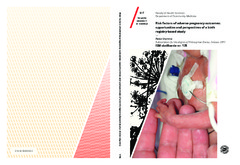| dc.contributor.advisor | Krettek, Alexandra | |
| dc.contributor.author | Usynina, Anna Alexandrovna | |
| dc.date.accessioned | 2017-02-10T13:22:03Z | |
| dc.date.available | 2017-02-10T13:22:03Z | |
| dc.date.issued | 2017-02-08 | |
| dc.description.abstract | Background: Preterm birth, perinatal death, and birth of babies small for gestational age are amongst common adverse pregnancy outcomes. Maternal lifestyle, mothers’ health status before and during pregnancy, previous adverse pregnancy outcomes as well as socio-demographic factors all influence perinatal mortality, prematurity, and small for gestational age birth. To date, despite many studies of multiple risk factors, data on factors contributing to adverse pregnancy outcomes in Northwest Russia are insufficient. The implementation of a regional birth registry in Murmansk County located in the Northwest Russia provided an opportunity to study different pregnancy outcomes in relation to selected risk factors.
Aims: The specific aims of this thesis were to 1) explore associations between selected maternal and fetal characteristics and perinatal mortality based on data from the Murmansk County Birth Registry in Russia; 2) estimate the prevalence of preterm birth in Murmansk County and to investigate associations between selected maternal factors and preterm birth; 3) examine maternal social risk factors for term small for gestational age births.
Methods: The study population included all 52 806 live- and stillbirths recorded in the Murmansk County Birth Registry during 2006-2011. Exclusion criteria different for studied pregnancy outcomes were used in prevalence analyses. Chi- squared tests were applied to evaluate differences in distribution of selected risk factors between groups with studied adverse pregnancy outcomes and groups without corresponding perinatal event. Logistic regression was used to estimate the effect of risk factors on studied pregnancy outcomes.
Results: Maternal low education, unmarried status, overweight or obesity, alcohol abuse, as well as preterm deliveries and abortions in mother’s medical history and antepartum hemorrhage and fetal growth retardation in current pregnancy associated with increased risk of perinatal mortality. Babies of underweight women were at lower risk of perinatal death. The prevalence of preterm birth ranged from 6.0% at 22-27 weeks gestation to 0.3% at 32-36 completed weeks, reaching 6.9% in total. Unmarried women, those with prior preterm birth, spontaneous or induced abortions had increased risk of preterm birth in current pregnancy. Additional risk factors varied throughout pregnancy. Maternal smoking and alcohol abuse increased the risk of term small for gestational age birth. Similar effect was observed in low educated, unemployed, and underweight women.
Conclusion: The Murmansk County Birth Registry served as an important tool to study risk factors for adverse pregnancy outcomes. This thesis demonstrated that both socio-demographic, lifestyle and medical factors contribute to perinatal death, preterm birth, and small for gestational age birth in Northwest Russia.
Public health efforts should therefore focus on reducing smoking, alcohol consumption, and underweight and good nutrition in women planning pregnancy. | en_US |
| dc.description.doctoraltype | ph.d. | en_US |
| dc.description.popularabstract | This thesis investigated risk factors of fetal and newborn deaths, as well as preterm birth and birth of babies small for date in Northwest Russia. We used data from a regional birth registry. Maternal low education, unmarried status, overweight or obesity, alcohol abuse, as well as preterm deliveries and abortions in mother’s medical history and antepartum hemorrhage and fetal growth retardation in current pregnancy associated with increased risk of fetal and newborn deaths. Babies of underweight women were at lower risk of that death. Unmarried women, those with prior preterm birth, spontaneous or induced abortions had increased risk of preterm birth in current pregnancy. Maternal smoking and alcohol abuse increased the risk of term small for gestational age birth. Similar effect was observed in low educated, unemployed, and underweight women. | en_US |
| dc.identifier.uri | https://hdl.handle.net/10037/10288 | |
| dc.language.iso | eng | en_US |
| dc.publisher | UiT The Arctic University of Norway | en_US |
| dc.publisher | UiT Norges arktiske universitet | en_US |
| dc.relation.ispartofseries | ISM skriftserie; 178 | |
| dc.rights.accessRights | openAccess | en_US |
| dc.rights.holder | Copyright 2017 The Author(s) | |
| dc.rights.uri | https://creativecommons.org/licenses/by-nc-sa/3.0 | en_US |
| dc.rights | Attribution-NonCommercial-ShareAlike 3.0 Unported (CC BY-NC-SA 3.0) | en_US |
| dc.subject | VDP::Medical disciplines: 700::Health sciences: 800::Community medicine, Social medicine: 801 | en_US |
| dc.subject | VDP::Medisinske Fag: 700::Helsefag: 800::Samfunnsmedisin, sosialmedisin: 801 | en_US |
| dc.subject | VDP::Medical disciplines: 700::Health sciences: 800::Preventive medicine: 804 | en_US |
| dc.subject | VDP::Medisinske Fag: 700::Helsefag: 800::Forebyggende medisin: 804 | en_US |
| dc.title | Risk factors of adverse pregnancy outcomes: opportunities and perspectives of a birth registry-based study | en_US |
| dc.type | Doctoral thesis | en_US |
| dc.type | Doktorgradsavhandling | en_US |


 English
English norsk
norsk



